-
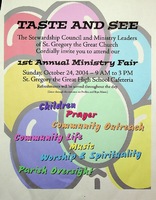 St. Gregory's 1st Annual Ministry Fair
St. Gregory's 1st Annual Ministry Fair This is a flyer of the 1st Annual Ministry Fair at St. Gregory in 2004. The Stewardship Council and Ministry Leaders have created this to engage with the community. The event went on from 9 in the morning until 3 in the afternoon. It was held at St. Gregory's High School Cafeteria. Some things they were offering at this fair were "prayer, music, worship & spirituality, parish oversight," etc. The flyer has colorful balloons as the background. The Parish believed that having time for play is an essential for the “Parish family.” Each week the Parish provided a schedule with different activities on the bulletin board or in the parish paper. Some of these activities included festivals, boy/girl scouts, bowling, BINGO, etc.
-
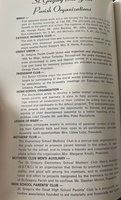 St. Gregory's Activities and Organizations 1978
St. Gregory's Activities and Organizations 1978 This is the parish activities list from St. Gregory's 75th anniversary booklet published in 1978. The activities and organizations listed show the parish made an effort to include activities that would appeal to parishioners regardless of age or gender. The offerings include social clubs, faith and prayer groups, educational opportunities, games, scouting, and even a credit union. St. Gregory’s served as a major gathering space for the Catholic community in Andersonville. The resources provided would be incredibly important to the parish population it served. Though not all, some of these resources, such as the credit union, remain today.
-
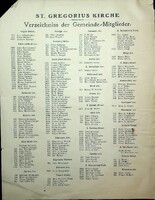 List of the Luxembourger parishioners in German
List of the Luxembourger parishioners in German Luxembourgers settled in Chicago in the 1840s, some of them forming a tight knit community in the Summerdale neighborhood in Chicago. These Luxembourgers comprised of the original founders of the St. Gregory the Great Parish.
-
 St. Gregory High School Activities in 1973
St. Gregory High School Activities in 1973 These images depict a variety of activities from a 1973 high school yearbook, showcasing the vibrant student life and diversity of interests at the time.
The first page includes snapshots of school assemblies and spirited events. We see a student, humorously "killed" for not eating a popular chocolate bar, and another playing his part in a Junior skit with a mop. The enthusiasm of the freshmen at their first assembly is palpable, as is the creativity of students impersonating the Bunkers, likely from the famous TV show "All in the Family". An alumni group is shown revisiting their high school days during a Homecoming Pep Rally, a testament to the lasting bonds and traditions that high school can create.
The second page turns to the quieter side of student activities: chess and horseback riding. Chess, popular among the students, was played anywhere possible, symbolizing strategic thinking and competition. Although a ski club faced weather challenges, their spirit of adventure is noteworthy. The Faculty-Student Sailing Club highlights the collaboration between students and staff, with plans for Lake Michigan excursions emphasizing a sense of exploration and learning beyond the classroom.
Together, these pages tell a story of a high school experience filled with laughter, learning, and the pursuit of a myriad of interests, from the performative to the intellectually challenging and the adventurous.
-
 First Simbang Gabi at St. Gregory 1987
First Simbang Gabi at St. Gregory 1987 Since the 1980s, the Filipino community has been very active in the parish. The Philippines is home to the largest Catholic population outside the Americas and with the parish's rich history of welcoming immigrant and first generation American families it is home to a large Filipino American community. Beginning in 1987, the congregations of Filipinos began hosting the Simbang Gabi, which is a series of masses done in preparation for Christmas by Filipino Catholics.
-
 St. Gregory's Theater Group
St. Gregory's Theater Group These images are of the St. Gregory's High School Theater Group in 1914. Each photograph presents different costumes used in the plays within that year. These photographs were part of the St. Gregory High School yearbook. Doing theater at St. Gregory was part of the extracurricular programs that they offered. The Priests and Sisters contributed to these extra curricular activities. Their goal is to make sure students learned “spiritually, academically, and culturally." On one of the pages, they titled it "School Entertainment—June 1914" and at the bottom wrote "Gregory Club Players." One the second page it states, "Pathway from School to Sisters' House" and "Players—June 1914."
-
 St. Gregory Bingo Games Assignments Sheet
St. Gregory Bingo Games Assignments Sheet This is an assignment sheet for Bingo Games at St. Gregory the Great Church. For each Bingo night, different individuals were assigned to run the games. This spanned from December 17, 1939 until December 15, 1940. The Parish believed that having time for play is an essential for the “Parish family.” Each week the Parish provided a schedule with different activities on the bulletin board or in the parish paper. Some of these activities included festivals, boy/girl scouts, bowling, BINGO, etc.
-
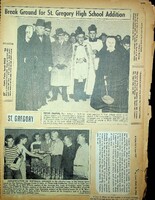 Break Ground for St. Gregory High School Addition
Break Ground for St. Gregory High School Addition This is a newspaper page explaining the renovations being done to the St. Gregory High School. They planned on expanding the school by adding four stories to the building. Rev. Arthur F. Terlecke, who was the pastor of St. Gregory at the time, was excited to announce two new units being added to the High School. He explained that the renovations will cost around $600,000 (~ $6,966,513 as of 2024). In the photograph, Rev. Arthur F. Terlecke is standing in the middle with his committee.
-
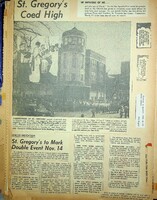 St. Gregory's Coed High School
St. Gregory's Coed High School This is a newspaper page explaining the Coed High School system at St. Gregory in 1940. Their new High School was renovated to cover almost the whole block — this included the church itself, the High School, Deaf School, Gymnasium, Parish Center, etc. The image presented is of the St. Gregory High School. To celebrate this new era for the St. Gregory High School, they created an abstract event. On the photograph on the left, Rev. Arthur F. Terlecke is holding biretta, along with the prayers of Cardinal Stritch. The photograph on the right side is of the abstract event.
-
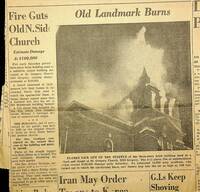 Fire Guts Old North Side Church
Fire Guts Old North Side Church This is a newspaper page explaining the fire that went down at the St. Gregory the Great church in 1951. The image presented on the page is of the St. Gregory chapel covered in smoke. The fire had affected both the church and the school. The fire started on the second floor and moved quickly within the building. It got to the point where the roof even collapsed. The newspaper also stated that repairs would cost approximately $100,000 (~ $1,201,276 as of 2024).
-
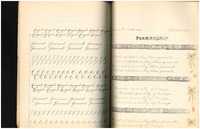 Student Penmanship Practice
Student Penmanship Practice These are notes from a St. Gregory's student, Corinne Adams, who attended in the 1910s. Many schools during this time placed much emphasis on proper penmanship. These papers show practice with writing specific letters, names, checks, and even full stories.
-
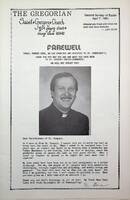 The Gregorian (April, 1991)
The Gregorian (April, 1991) This is a monthly newsletter of St. Gregory Church in Chicago titled "The Gregorian," dated April 1991. The central theme of this edition is a farewell to Father Gene, as indicated by the large "FAREWELL" text. Below this headline, the newsletter expresses gratitude and good wishes to Father Gene as he leaves for St. Genevieve's, acknowledging his contributions to the St. Gregory Parish community. A message assures Father Gene that he will not be forgotten.
A photograph of Father Gene smiling is featured, providing a personal connection to the readers. Below his picture is a heartfelt letter addressed to the parishioners of St. Gregory. In this letter, Father Gene reflects on his time at the parish, describing it as one of his best assignments and expressing his deep appreciation for the supportive and loving community. He mentions the generosity and warmth he has received and assures the parishioners that the experiences he has had will be carried with him in the future. He concludes by expressing his gratitude, bestowing blessings, and mentioning his final Mass as an act of Thanksgiving, signed with his name.
-
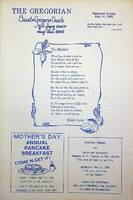 The Gregorian (May, 1989)
The Gregorian (May, 1989) This is a monthly newsletter of St. Gregory Church in Chicago titled "The Gregorian," dated May 14, 1989. The date at the top right indicates it's for Pentecost Sunday, May 14, 1989, and a biblical quote from John 20:21b complements the date.
The header of the newsletter is stylized with the title "THE GREGORIAN" in bold, uppercase letters. Below this, in a more decorative font, is "Saint Gregory Church" with its address.
The central part of the page is dedicated to a poem titled "To Mother," which is a touching tribute to motherhood, framed with an illustration of a ribbon and a flower, likely symbolizing love and purity. The poem conveys the theme of divine love and the sacredness of the mother-child relationship, suggested by the lines that speak of Jesus sending the speaker to a caring mother.
In the lower section, there are two announcements framed in boxes. The left one advertises a "MOTHER'S DAY ANNUAL PANCAKE BREAKFAST," encouraging attendance with a whimsical drawing of pancakes and coffee, sponsored by Boy Scout Troop #829. The right one announces "SPIRITUAL RENEWAL" for various church volunteers, detailing an upcoming event with Father Gene Gratkowski.
These components illustrate the newsletter's purpose: to inform the church community about events, celebrate significant occasions, and foster a sense of unity and spirituality among the congregation.
-
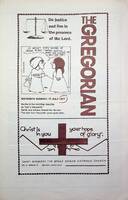 The Gregorian (July, 1977)
The Gregorian (July, 1977) This is a monthly newsletter of St. Gregory Church in Chicago titled "The Gregorian," dated July 17, 1977. The publication appears to be St. Gregory the Great Roman Catholic Church's newsletter, based on the address listed at the bottom. The design is straightforward, with large, bold text and simple graphics.
At the top, a stylized scale symbolizes justice, accompanied by the phrase "Do justice and live in the presence of the Lord." Below this is a cartoon with two figures, one serving the other a bowl, captioned with a biblical reference to Martha and Mary, highlighting the choice of spiritual devotion over mundane tasks.
The middle section contains the title "THE GREGORIAN" in large block letters, with a text block beneath it referencing Martha as "just a housewife," alluding to her biblical story of hospitality and service, and noting that saints and sinners shared her dinners, with Jesus frequently visiting.
The bottom section includes a Christian message, "Christ is in you your hope of glory," superimposed on a large cross graphic, reinforcing the newsletter's religious content and inspiration.
The footer identifies the publication as belonging to "SAINT GREGORY THE GREAT ROMAN CATHOLIC CHURCH," providing an address in Chicago, Illinois. This page exemplifies the church's outreach and communication with its congregation, using a blend of religious instruction, scriptural reference, and community building in a format typical of a monthly newsletter.
-
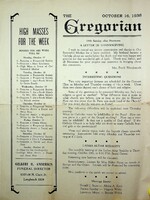 The Gregorian (October, 1938)
The Gregorian (October, 1938) This is a monthly newsletter of St. Gregory Church in Chicago titled "The Gregorian," dated October 16, 1938. The layout includes a header on top with the newsletter's title in a prominent font, flanked by two decorative lines. Below this, the page is divided into two columns of text.
The left column, under the heading "HIGH MASSES FOR THE WEEK," lists the schedule of masses for each day of the week, from Monday, October 17, to Sunday, October 23. It mentions specific types of masses such as Requiem masses and High Mass in honor of Our Sorrowful Mother, some with associated names, indicating masses dedicated to particular individuals or societies within the church.
On the right side, there are several sections starting with "A LETTER OF THANKSGIVING" from a parishioner expressing gratitude for her husband's conversion to Catholicism. Below that is a section titled "INTERESTING QUESTIONS" which previews lectures on faith and challenges to the church's teachings that are to be addressed in a Convert Class. It encourages engagement with these topics and announces the time for instruction classes.
Further down, "LADIES ALTAR SODALITY" announces a meeting and lecture, inviting new residents to attend. At the bottom, "Marriage Banns" lists couples who have announced their intentions to marry.
A footer on the page advertises for a funeral director, indicating the newsletter's role in community information sharing. "The Gregorian" seems to function as a monthly bulletin, informing parish members about liturgical schedules, church-related news, educational opportunities, and social events.
-
 The Gregorian (October, 1932)
The Gregorian (October, 1932) This is a monthly newsletter of St. Gregory Church in Chicago titled "The Gregorian," dated October 1932. The page layout includes two columns of text with a variety of headings and one small inset image at the top center, depicting what seems to be the religious figure, The Lady of Perpetual hope. The headings include "OUR CARNIVAL," "NECESSARY ITEM," "OUR NOVENA," "EVENING SERVICES," "OUR PURGATORIAL SOCIETY," and "CLOTHES WANTED." This newsletter serves as a historical document, providing insights into the community activities, religious practices, and communal concerns of the parish at that time.
-
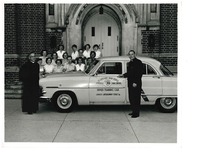 Photograph of Drivers Ed Class
Photograph of Drivers Ed Class Students and faculty posing with a school driver's education car in the 1950s or early 60s. During this time driver's education courses were often included in school, sometimes as a substitute or along with physical education classes. This gave students a good opportunity to practice their driving skills before receiving their driver's licenses and better prepare them for the roads.
-
 First Boy's Choir
First Boy's Choir This is the first boy's choir of St. Gregory's. This photo would have been taken around 1905-7.
-
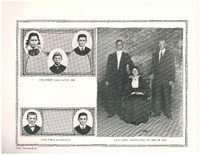 First Graduates of St. Gregorys's
First Graduates of St. Gregorys's The three children on the left are pictured during the start of their education at St. Gregory's in 1906. The two boys are pictured again showing saying that they were the first altar boys. Then all three were pictured in 1914 when they graduated.
-
 School Activities-1970s
School Activities-1970s Various school activities shown from the churches 75th anniversary booklet. School children of various age groups are shown in an out of classroom settings.
-
 Countries of origin of immigrant parishioners in 1954
Countries of origin of immigrant parishioners in 1954 Page from Jubilee handbook listing countries of origin of immigrant parishioners in 1954.
-
 A block stamp illustrating "The Church Beautiful" pamphlet
A block stamp illustrating "The Church Beautiful" pamphlet This item is a block stamp of lectern and pulpit used by Fr. Klasen in 1942 to illustrate his "The Church Beautiful" pamphlet about art at St. Gregory the Great church in Chicago, Illinois. Klasen originally petitioned for the creation of a church that would stand out; "You may build, but build something distinctive, not just another 'catalogue' church." He took great pride in the beauty of the church and the artworks housed in St. Gregory the Great. This block depicts the Lectern and pulpit of the church. In it's illustration, these stamps utilized a chemical process to transfer the image from the block onto the paper. Klasen describes the intricate details carved on the Lectern which includes imagery of an eagle, the symbol of St. John the Evangelist, and a group of angles. Klasen believed that this piece was a masterpiece and truly admired the beauty. His pamphlet "The Church Beautiful" helps explain the artwork and architecture of the church in great depth in order for people to understand and appreciate the masterpieces.
-
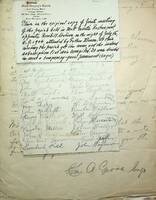 The first meeting of St. Gregory the Great parish
The first meeting of St. Gregory the Great parish This item is the original copy of the first meeting of the St. Gregory the Great parish in Chicago, Illinois. This meeting took place on July 15, 1904, shortly after the parish received permission from the Archbishop to be founded. This meeting was held in Matt Evert's restaurant which was located opposite of the Rosehill station afterhours. St. Gregory the Great parish had faced many challenges with getting permission to establish a parish with the Archbishop. The meeting having to be held at a restaurant is reminiscent of both these challenges and the resilience of the community in establishing a church. This meeting was attended by the chosen founding Fr. Klasen. Here, the parish compiled the first subscription list for it's members. The names fill two pages which were attached to a paper of the meeting notes. Additionally, the parish decided to erect a semi-permeant but temporary place of worship, which was used for 20 years, before the building of the 1926 Norman-Gothic church. A list of the 20 attendees is also included.
-
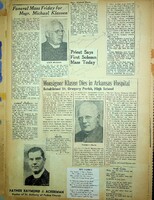 St. Gregory parishioner's scrapbook page including newspaper clippings of Fr. Klasen's passing
St. Gregory parishioner's scrapbook page including newspaper clippings of Fr. Klasen's passing This item is a page of a parishioner's scrapbook composing mainly of historic news clippings of St. Gregory the Great. This scrapbook was created by a parishioner dedicated to the history of St. Gregory the Great and aimed to help preserve it's history. This page features the event of the parish's founding Fr. Klasen passing. The page combines articles about the Friday Funeral Mass for Klasen, the original report on his death at an Arkansas hospital, and his obituary.
-
 Image of the original church committee of St. Gregory the Great
Image of the original church committee of St. Gregory the Great This is an image of the Church Committee for St. Gregory the Great parish in the formerly Summerdale neighborhood in Chicago, Illinois. This committee was founded in the spring of 1904 due to a need for a German- speaking parish in this neighborhood to accommodate a community of immigrants from Luxembourg. This committee petitioned to Reverend Archbishop J. E. Quigley and the Archdiocese for the creation of this parish. They had collected the names of potential parishioners and promised this parish would foster a beautiful community. These devoted committee members eventually accomplished their goal after a lengthy period of communication with the Archdiocese. Their proposition to establish the parish of St. Gregory the Great was accepted late in 1904. This committee continued to be integral after the building of the original church building commenced. They were responsible for proposing the appointment of the founding pastor and organizing the first meetings of the parish.
 St. Gregory's 1st Annual Ministry Fair This is a flyer of the 1st Annual Ministry Fair at St. Gregory in 2004. The Stewardship Council and Ministry Leaders have created this to engage with the community. The event went on from 9 in the morning until 3 in the afternoon. It was held at St. Gregory's High School Cafeteria. Some things they were offering at this fair were "prayer, music, worship & spirituality, parish oversight," etc. The flyer has colorful balloons as the background. The Parish believed that having time for play is an essential for the “Parish family.” Each week the Parish provided a schedule with different activities on the bulletin board or in the parish paper. Some of these activities included festivals, boy/girl scouts, bowling, BINGO, etc.
St. Gregory's 1st Annual Ministry Fair This is a flyer of the 1st Annual Ministry Fair at St. Gregory in 2004. The Stewardship Council and Ministry Leaders have created this to engage with the community. The event went on from 9 in the morning until 3 in the afternoon. It was held at St. Gregory's High School Cafeteria. Some things they were offering at this fair were "prayer, music, worship & spirituality, parish oversight," etc. The flyer has colorful balloons as the background. The Parish believed that having time for play is an essential for the “Parish family.” Each week the Parish provided a schedule with different activities on the bulletin board or in the parish paper. Some of these activities included festivals, boy/girl scouts, bowling, BINGO, etc. St. Gregory's Activities and Organizations 1978 This is the parish activities list from St. Gregory's 75th anniversary booklet published in 1978. The activities and organizations listed show the parish made an effort to include activities that would appeal to parishioners regardless of age or gender. The offerings include social clubs, faith and prayer groups, educational opportunities, games, scouting, and even a credit union. St. Gregory’s served as a major gathering space for the Catholic community in Andersonville. The resources provided would be incredibly important to the parish population it served. Though not all, some of these resources, such as the credit union, remain today.
St. Gregory's Activities and Organizations 1978 This is the parish activities list from St. Gregory's 75th anniversary booklet published in 1978. The activities and organizations listed show the parish made an effort to include activities that would appeal to parishioners regardless of age or gender. The offerings include social clubs, faith and prayer groups, educational opportunities, games, scouting, and even a credit union. St. Gregory’s served as a major gathering space for the Catholic community in Andersonville. The resources provided would be incredibly important to the parish population it served. Though not all, some of these resources, such as the credit union, remain today. List of the Luxembourger parishioners in German Luxembourgers settled in Chicago in the 1840s, some of them forming a tight knit community in the Summerdale neighborhood in Chicago. These Luxembourgers comprised of the original founders of the St. Gregory the Great Parish.
List of the Luxembourger parishioners in German Luxembourgers settled in Chicago in the 1840s, some of them forming a tight knit community in the Summerdale neighborhood in Chicago. These Luxembourgers comprised of the original founders of the St. Gregory the Great Parish. St. Gregory High School Activities in 1973 These images depict a variety of activities from a 1973 high school yearbook, showcasing the vibrant student life and diversity of interests at the time. The first page includes snapshots of school assemblies and spirited events. We see a student, humorously "killed" for not eating a popular chocolate bar, and another playing his part in a Junior skit with a mop. The enthusiasm of the freshmen at their first assembly is palpable, as is the creativity of students impersonating the Bunkers, likely from the famous TV show "All in the Family". An alumni group is shown revisiting their high school days during a Homecoming Pep Rally, a testament to the lasting bonds and traditions that high school can create. The second page turns to the quieter side of student activities: chess and horseback riding. Chess, popular among the students, was played anywhere possible, symbolizing strategic thinking and competition. Although a ski club faced weather challenges, their spirit of adventure is noteworthy. The Faculty-Student Sailing Club highlights the collaboration between students and staff, with plans for Lake Michigan excursions emphasizing a sense of exploration and learning beyond the classroom. Together, these pages tell a story of a high school experience filled with laughter, learning, and the pursuit of a myriad of interests, from the performative to the intellectually challenging and the adventurous.
St. Gregory High School Activities in 1973 These images depict a variety of activities from a 1973 high school yearbook, showcasing the vibrant student life and diversity of interests at the time. The first page includes snapshots of school assemblies and spirited events. We see a student, humorously "killed" for not eating a popular chocolate bar, and another playing his part in a Junior skit with a mop. The enthusiasm of the freshmen at their first assembly is palpable, as is the creativity of students impersonating the Bunkers, likely from the famous TV show "All in the Family". An alumni group is shown revisiting their high school days during a Homecoming Pep Rally, a testament to the lasting bonds and traditions that high school can create. The second page turns to the quieter side of student activities: chess and horseback riding. Chess, popular among the students, was played anywhere possible, symbolizing strategic thinking and competition. Although a ski club faced weather challenges, their spirit of adventure is noteworthy. The Faculty-Student Sailing Club highlights the collaboration between students and staff, with plans for Lake Michigan excursions emphasizing a sense of exploration and learning beyond the classroom. Together, these pages tell a story of a high school experience filled with laughter, learning, and the pursuit of a myriad of interests, from the performative to the intellectually challenging and the adventurous. First Simbang Gabi at St. Gregory 1987 Since the 1980s, the Filipino community has been very active in the parish. The Philippines is home to the largest Catholic population outside the Americas and with the parish's rich history of welcoming immigrant and first generation American families it is home to a large Filipino American community. Beginning in 1987, the congregations of Filipinos began hosting the Simbang Gabi, which is a series of masses done in preparation for Christmas by Filipino Catholics.
First Simbang Gabi at St. Gregory 1987 Since the 1980s, the Filipino community has been very active in the parish. The Philippines is home to the largest Catholic population outside the Americas and with the parish's rich history of welcoming immigrant and first generation American families it is home to a large Filipino American community. Beginning in 1987, the congregations of Filipinos began hosting the Simbang Gabi, which is a series of masses done in preparation for Christmas by Filipino Catholics. St. Gregory's Theater Group These images are of the St. Gregory's High School Theater Group in 1914. Each photograph presents different costumes used in the plays within that year. These photographs were part of the St. Gregory High School yearbook. Doing theater at St. Gregory was part of the extracurricular programs that they offered. The Priests and Sisters contributed to these extra curricular activities. Their goal is to make sure students learned “spiritually, academically, and culturally." On one of the pages, they titled it "School Entertainment—June 1914" and at the bottom wrote "Gregory Club Players." One the second page it states, "Pathway from School to Sisters' House" and "Players—June 1914."
St. Gregory's Theater Group These images are of the St. Gregory's High School Theater Group in 1914. Each photograph presents different costumes used in the plays within that year. These photographs were part of the St. Gregory High School yearbook. Doing theater at St. Gregory was part of the extracurricular programs that they offered. The Priests and Sisters contributed to these extra curricular activities. Their goal is to make sure students learned “spiritually, academically, and culturally." On one of the pages, they titled it "School Entertainment—June 1914" and at the bottom wrote "Gregory Club Players." One the second page it states, "Pathway from School to Sisters' House" and "Players—June 1914." St. Gregory Bingo Games Assignments Sheet This is an assignment sheet for Bingo Games at St. Gregory the Great Church. For each Bingo night, different individuals were assigned to run the games. This spanned from December 17, 1939 until December 15, 1940. The Parish believed that having time for play is an essential for the “Parish family.” Each week the Parish provided a schedule with different activities on the bulletin board or in the parish paper. Some of these activities included festivals, boy/girl scouts, bowling, BINGO, etc.
St. Gregory Bingo Games Assignments Sheet This is an assignment sheet for Bingo Games at St. Gregory the Great Church. For each Bingo night, different individuals were assigned to run the games. This spanned from December 17, 1939 until December 15, 1940. The Parish believed that having time for play is an essential for the “Parish family.” Each week the Parish provided a schedule with different activities on the bulletin board or in the parish paper. Some of these activities included festivals, boy/girl scouts, bowling, BINGO, etc. Break Ground for St. Gregory High School Addition This is a newspaper page explaining the renovations being done to the St. Gregory High School. They planned on expanding the school by adding four stories to the building. Rev. Arthur F. Terlecke, who was the pastor of St. Gregory at the time, was excited to announce two new units being added to the High School. He explained that the renovations will cost around $600,000 (~ $6,966,513 as of 2024). In the photograph, Rev. Arthur F. Terlecke is standing in the middle with his committee.
Break Ground for St. Gregory High School Addition This is a newspaper page explaining the renovations being done to the St. Gregory High School. They planned on expanding the school by adding four stories to the building. Rev. Arthur F. Terlecke, who was the pastor of St. Gregory at the time, was excited to announce two new units being added to the High School. He explained that the renovations will cost around $600,000 (~ $6,966,513 as of 2024). In the photograph, Rev. Arthur F. Terlecke is standing in the middle with his committee. St. Gregory's Coed High School This is a newspaper page explaining the Coed High School system at St. Gregory in 1940. Their new High School was renovated to cover almost the whole block — this included the church itself, the High School, Deaf School, Gymnasium, Parish Center, etc. The image presented is of the St. Gregory High School. To celebrate this new era for the St. Gregory High School, they created an abstract event. On the photograph on the left, Rev. Arthur F. Terlecke is holding biretta, along with the prayers of Cardinal Stritch. The photograph on the right side is of the abstract event.
St. Gregory's Coed High School This is a newspaper page explaining the Coed High School system at St. Gregory in 1940. Their new High School was renovated to cover almost the whole block — this included the church itself, the High School, Deaf School, Gymnasium, Parish Center, etc. The image presented is of the St. Gregory High School. To celebrate this new era for the St. Gregory High School, they created an abstract event. On the photograph on the left, Rev. Arthur F. Terlecke is holding biretta, along with the prayers of Cardinal Stritch. The photograph on the right side is of the abstract event. Fire Guts Old North Side Church This is a newspaper page explaining the fire that went down at the St. Gregory the Great church in 1951. The image presented on the page is of the St. Gregory chapel covered in smoke. The fire had affected both the church and the school. The fire started on the second floor and moved quickly within the building. It got to the point where the roof even collapsed. The newspaper also stated that repairs would cost approximately $100,000 (~ $1,201,276 as of 2024).
Fire Guts Old North Side Church This is a newspaper page explaining the fire that went down at the St. Gregory the Great church in 1951. The image presented on the page is of the St. Gregory chapel covered in smoke. The fire had affected both the church and the school. The fire started on the second floor and moved quickly within the building. It got to the point where the roof even collapsed. The newspaper also stated that repairs would cost approximately $100,000 (~ $1,201,276 as of 2024). Student Penmanship Practice These are notes from a St. Gregory's student, Corinne Adams, who attended in the 1910s. Many schools during this time placed much emphasis on proper penmanship. These papers show practice with writing specific letters, names, checks, and even full stories.
Student Penmanship Practice These are notes from a St. Gregory's student, Corinne Adams, who attended in the 1910s. Many schools during this time placed much emphasis on proper penmanship. These papers show practice with writing specific letters, names, checks, and even full stories. The Gregorian (April, 1991) This is a monthly newsletter of St. Gregory Church in Chicago titled "The Gregorian," dated April 1991. The central theme of this edition is a farewell to Father Gene, as indicated by the large "FAREWELL" text. Below this headline, the newsletter expresses gratitude and good wishes to Father Gene as he leaves for St. Genevieve's, acknowledging his contributions to the St. Gregory Parish community. A message assures Father Gene that he will not be forgotten. A photograph of Father Gene smiling is featured, providing a personal connection to the readers. Below his picture is a heartfelt letter addressed to the parishioners of St. Gregory. In this letter, Father Gene reflects on his time at the parish, describing it as one of his best assignments and expressing his deep appreciation for the supportive and loving community. He mentions the generosity and warmth he has received and assures the parishioners that the experiences he has had will be carried with him in the future. He concludes by expressing his gratitude, bestowing blessings, and mentioning his final Mass as an act of Thanksgiving, signed with his name.
The Gregorian (April, 1991) This is a monthly newsletter of St. Gregory Church in Chicago titled "The Gregorian," dated April 1991. The central theme of this edition is a farewell to Father Gene, as indicated by the large "FAREWELL" text. Below this headline, the newsletter expresses gratitude and good wishes to Father Gene as he leaves for St. Genevieve's, acknowledging his contributions to the St. Gregory Parish community. A message assures Father Gene that he will not be forgotten. A photograph of Father Gene smiling is featured, providing a personal connection to the readers. Below his picture is a heartfelt letter addressed to the parishioners of St. Gregory. In this letter, Father Gene reflects on his time at the parish, describing it as one of his best assignments and expressing his deep appreciation for the supportive and loving community. He mentions the generosity and warmth he has received and assures the parishioners that the experiences he has had will be carried with him in the future. He concludes by expressing his gratitude, bestowing blessings, and mentioning his final Mass as an act of Thanksgiving, signed with his name. The Gregorian (May, 1989) This is a monthly newsletter of St. Gregory Church in Chicago titled "The Gregorian," dated May 14, 1989. The date at the top right indicates it's for Pentecost Sunday, May 14, 1989, and a biblical quote from John 20:21b complements the date. The header of the newsletter is stylized with the title "THE GREGORIAN" in bold, uppercase letters. Below this, in a more decorative font, is "Saint Gregory Church" with its address. The central part of the page is dedicated to a poem titled "To Mother," which is a touching tribute to motherhood, framed with an illustration of a ribbon and a flower, likely symbolizing love and purity. The poem conveys the theme of divine love and the sacredness of the mother-child relationship, suggested by the lines that speak of Jesus sending the speaker to a caring mother. In the lower section, there are two announcements framed in boxes. The left one advertises a "MOTHER'S DAY ANNUAL PANCAKE BREAKFAST," encouraging attendance with a whimsical drawing of pancakes and coffee, sponsored by Boy Scout Troop #829. The right one announces "SPIRITUAL RENEWAL" for various church volunteers, detailing an upcoming event with Father Gene Gratkowski. These components illustrate the newsletter's purpose: to inform the church community about events, celebrate significant occasions, and foster a sense of unity and spirituality among the congregation.
The Gregorian (May, 1989) This is a monthly newsletter of St. Gregory Church in Chicago titled "The Gregorian," dated May 14, 1989. The date at the top right indicates it's for Pentecost Sunday, May 14, 1989, and a biblical quote from John 20:21b complements the date. The header of the newsletter is stylized with the title "THE GREGORIAN" in bold, uppercase letters. Below this, in a more decorative font, is "Saint Gregory Church" with its address. The central part of the page is dedicated to a poem titled "To Mother," which is a touching tribute to motherhood, framed with an illustration of a ribbon and a flower, likely symbolizing love and purity. The poem conveys the theme of divine love and the sacredness of the mother-child relationship, suggested by the lines that speak of Jesus sending the speaker to a caring mother. In the lower section, there are two announcements framed in boxes. The left one advertises a "MOTHER'S DAY ANNUAL PANCAKE BREAKFAST," encouraging attendance with a whimsical drawing of pancakes and coffee, sponsored by Boy Scout Troop #829. The right one announces "SPIRITUAL RENEWAL" for various church volunteers, detailing an upcoming event with Father Gene Gratkowski. These components illustrate the newsletter's purpose: to inform the church community about events, celebrate significant occasions, and foster a sense of unity and spirituality among the congregation. The Gregorian (July, 1977) This is a monthly newsletter of St. Gregory Church in Chicago titled "The Gregorian," dated July 17, 1977. The publication appears to be St. Gregory the Great Roman Catholic Church's newsletter, based on the address listed at the bottom. The design is straightforward, with large, bold text and simple graphics. At the top, a stylized scale symbolizes justice, accompanied by the phrase "Do justice and live in the presence of the Lord." Below this is a cartoon with two figures, one serving the other a bowl, captioned with a biblical reference to Martha and Mary, highlighting the choice of spiritual devotion over mundane tasks. The middle section contains the title "THE GREGORIAN" in large block letters, with a text block beneath it referencing Martha as "just a housewife," alluding to her biblical story of hospitality and service, and noting that saints and sinners shared her dinners, with Jesus frequently visiting. The bottom section includes a Christian message, "Christ is in you your hope of glory," superimposed on a large cross graphic, reinforcing the newsletter's religious content and inspiration. The footer identifies the publication as belonging to "SAINT GREGORY THE GREAT ROMAN CATHOLIC CHURCH," providing an address in Chicago, Illinois. This page exemplifies the church's outreach and communication with its congregation, using a blend of religious instruction, scriptural reference, and community building in a format typical of a monthly newsletter.
The Gregorian (July, 1977) This is a monthly newsletter of St. Gregory Church in Chicago titled "The Gregorian," dated July 17, 1977. The publication appears to be St. Gregory the Great Roman Catholic Church's newsletter, based on the address listed at the bottom. The design is straightforward, with large, bold text and simple graphics. At the top, a stylized scale symbolizes justice, accompanied by the phrase "Do justice and live in the presence of the Lord." Below this is a cartoon with two figures, one serving the other a bowl, captioned with a biblical reference to Martha and Mary, highlighting the choice of spiritual devotion over mundane tasks. The middle section contains the title "THE GREGORIAN" in large block letters, with a text block beneath it referencing Martha as "just a housewife," alluding to her biblical story of hospitality and service, and noting that saints and sinners shared her dinners, with Jesus frequently visiting. The bottom section includes a Christian message, "Christ is in you your hope of glory," superimposed on a large cross graphic, reinforcing the newsletter's religious content and inspiration. The footer identifies the publication as belonging to "SAINT GREGORY THE GREAT ROMAN CATHOLIC CHURCH," providing an address in Chicago, Illinois. This page exemplifies the church's outreach and communication with its congregation, using a blend of religious instruction, scriptural reference, and community building in a format typical of a monthly newsletter. The Gregorian (October, 1938) This is a monthly newsletter of St. Gregory Church in Chicago titled "The Gregorian," dated October 16, 1938. The layout includes a header on top with the newsletter's title in a prominent font, flanked by two decorative lines. Below this, the page is divided into two columns of text. The left column, under the heading "HIGH MASSES FOR THE WEEK," lists the schedule of masses for each day of the week, from Monday, October 17, to Sunday, October 23. It mentions specific types of masses such as Requiem masses and High Mass in honor of Our Sorrowful Mother, some with associated names, indicating masses dedicated to particular individuals or societies within the church. On the right side, there are several sections starting with "A LETTER OF THANKSGIVING" from a parishioner expressing gratitude for her husband's conversion to Catholicism. Below that is a section titled "INTERESTING QUESTIONS" which previews lectures on faith and challenges to the church's teachings that are to be addressed in a Convert Class. It encourages engagement with these topics and announces the time for instruction classes. Further down, "LADIES ALTAR SODALITY" announces a meeting and lecture, inviting new residents to attend. At the bottom, "Marriage Banns" lists couples who have announced their intentions to marry. A footer on the page advertises for a funeral director, indicating the newsletter's role in community information sharing. "The Gregorian" seems to function as a monthly bulletin, informing parish members about liturgical schedules, church-related news, educational opportunities, and social events.
The Gregorian (October, 1938) This is a monthly newsletter of St. Gregory Church in Chicago titled "The Gregorian," dated October 16, 1938. The layout includes a header on top with the newsletter's title in a prominent font, flanked by two decorative lines. Below this, the page is divided into two columns of text. The left column, under the heading "HIGH MASSES FOR THE WEEK," lists the schedule of masses for each day of the week, from Monday, October 17, to Sunday, October 23. It mentions specific types of masses such as Requiem masses and High Mass in honor of Our Sorrowful Mother, some with associated names, indicating masses dedicated to particular individuals or societies within the church. On the right side, there are several sections starting with "A LETTER OF THANKSGIVING" from a parishioner expressing gratitude for her husband's conversion to Catholicism. Below that is a section titled "INTERESTING QUESTIONS" which previews lectures on faith and challenges to the church's teachings that are to be addressed in a Convert Class. It encourages engagement with these topics and announces the time for instruction classes. Further down, "LADIES ALTAR SODALITY" announces a meeting and lecture, inviting new residents to attend. At the bottom, "Marriage Banns" lists couples who have announced their intentions to marry. A footer on the page advertises for a funeral director, indicating the newsletter's role in community information sharing. "The Gregorian" seems to function as a monthly bulletin, informing parish members about liturgical schedules, church-related news, educational opportunities, and social events. The Gregorian (October, 1932) This is a monthly newsletter of St. Gregory Church in Chicago titled "The Gregorian," dated October 1932. The page layout includes two columns of text with a variety of headings and one small inset image at the top center, depicting what seems to be the religious figure, The Lady of Perpetual hope. The headings include "OUR CARNIVAL," "NECESSARY ITEM," "OUR NOVENA," "EVENING SERVICES," "OUR PURGATORIAL SOCIETY," and "CLOTHES WANTED." This newsletter serves as a historical document, providing insights into the community activities, religious practices, and communal concerns of the parish at that time.
The Gregorian (October, 1932) This is a monthly newsletter of St. Gregory Church in Chicago titled "The Gregorian," dated October 1932. The page layout includes two columns of text with a variety of headings and one small inset image at the top center, depicting what seems to be the religious figure, The Lady of Perpetual hope. The headings include "OUR CARNIVAL," "NECESSARY ITEM," "OUR NOVENA," "EVENING SERVICES," "OUR PURGATORIAL SOCIETY," and "CLOTHES WANTED." This newsletter serves as a historical document, providing insights into the community activities, religious practices, and communal concerns of the parish at that time. Photograph of Drivers Ed Class Students and faculty posing with a school driver's education car in the 1950s or early 60s. During this time driver's education courses were often included in school, sometimes as a substitute or along with physical education classes. This gave students a good opportunity to practice their driving skills before receiving their driver's licenses and better prepare them for the roads.
Photograph of Drivers Ed Class Students and faculty posing with a school driver's education car in the 1950s or early 60s. During this time driver's education courses were often included in school, sometimes as a substitute or along with physical education classes. This gave students a good opportunity to practice their driving skills before receiving their driver's licenses and better prepare them for the roads. First Boy's Choir This is the first boy's choir of St. Gregory's. This photo would have been taken around 1905-7.
First Boy's Choir This is the first boy's choir of St. Gregory's. This photo would have been taken around 1905-7. First Graduates of St. Gregorys's The three children on the left are pictured during the start of their education at St. Gregory's in 1906. The two boys are pictured again showing saying that they were the first altar boys. Then all three were pictured in 1914 when they graduated.
First Graduates of St. Gregorys's The three children on the left are pictured during the start of their education at St. Gregory's in 1906. The two boys are pictured again showing saying that they were the first altar boys. Then all three were pictured in 1914 when they graduated. School Activities-1970s Various school activities shown from the churches 75th anniversary booklet. School children of various age groups are shown in an out of classroom settings.
School Activities-1970s Various school activities shown from the churches 75th anniversary booklet. School children of various age groups are shown in an out of classroom settings. Countries of origin of immigrant parishioners in 1954 Page from Jubilee handbook listing countries of origin of immigrant parishioners in 1954.
Countries of origin of immigrant parishioners in 1954 Page from Jubilee handbook listing countries of origin of immigrant parishioners in 1954. A block stamp illustrating "The Church Beautiful" pamphlet This item is a block stamp of lectern and pulpit used by Fr. Klasen in 1942 to illustrate his "The Church Beautiful" pamphlet about art at St. Gregory the Great church in Chicago, Illinois. Klasen originally petitioned for the creation of a church that would stand out; "You may build, but build something distinctive, not just another 'catalogue' church." He took great pride in the beauty of the church and the artworks housed in St. Gregory the Great. This block depicts the Lectern and pulpit of the church. In it's illustration, these stamps utilized a chemical process to transfer the image from the block onto the paper. Klasen describes the intricate details carved on the Lectern which includes imagery of an eagle, the symbol of St. John the Evangelist, and a group of angles. Klasen believed that this piece was a masterpiece and truly admired the beauty. His pamphlet "The Church Beautiful" helps explain the artwork and architecture of the church in great depth in order for people to understand and appreciate the masterpieces.
A block stamp illustrating "The Church Beautiful" pamphlet This item is a block stamp of lectern and pulpit used by Fr. Klasen in 1942 to illustrate his "The Church Beautiful" pamphlet about art at St. Gregory the Great church in Chicago, Illinois. Klasen originally petitioned for the creation of a church that would stand out; "You may build, but build something distinctive, not just another 'catalogue' church." He took great pride in the beauty of the church and the artworks housed in St. Gregory the Great. This block depicts the Lectern and pulpit of the church. In it's illustration, these stamps utilized a chemical process to transfer the image from the block onto the paper. Klasen describes the intricate details carved on the Lectern which includes imagery of an eagle, the symbol of St. John the Evangelist, and a group of angles. Klasen believed that this piece was a masterpiece and truly admired the beauty. His pamphlet "The Church Beautiful" helps explain the artwork and architecture of the church in great depth in order for people to understand and appreciate the masterpieces. The first meeting of St. Gregory the Great parish This item is the original copy of the first meeting of the St. Gregory the Great parish in Chicago, Illinois. This meeting took place on July 15, 1904, shortly after the parish received permission from the Archbishop to be founded. This meeting was held in Matt Evert's restaurant which was located opposite of the Rosehill station afterhours. St. Gregory the Great parish had faced many challenges with getting permission to establish a parish with the Archbishop. The meeting having to be held at a restaurant is reminiscent of both these challenges and the resilience of the community in establishing a church. This meeting was attended by the chosen founding Fr. Klasen. Here, the parish compiled the first subscription list for it's members. The names fill two pages which were attached to a paper of the meeting notes. Additionally, the parish decided to erect a semi-permeant but temporary place of worship, which was used for 20 years, before the building of the 1926 Norman-Gothic church. A list of the 20 attendees is also included.
The first meeting of St. Gregory the Great parish This item is the original copy of the first meeting of the St. Gregory the Great parish in Chicago, Illinois. This meeting took place on July 15, 1904, shortly after the parish received permission from the Archbishop to be founded. This meeting was held in Matt Evert's restaurant which was located opposite of the Rosehill station afterhours. St. Gregory the Great parish had faced many challenges with getting permission to establish a parish with the Archbishop. The meeting having to be held at a restaurant is reminiscent of both these challenges and the resilience of the community in establishing a church. This meeting was attended by the chosen founding Fr. Klasen. Here, the parish compiled the first subscription list for it's members. The names fill two pages which were attached to a paper of the meeting notes. Additionally, the parish decided to erect a semi-permeant but temporary place of worship, which was used for 20 years, before the building of the 1926 Norman-Gothic church. A list of the 20 attendees is also included. St. Gregory parishioner's scrapbook page including newspaper clippings of Fr. Klasen's passing This item is a page of a parishioner's scrapbook composing mainly of historic news clippings of St. Gregory the Great. This scrapbook was created by a parishioner dedicated to the history of St. Gregory the Great and aimed to help preserve it's history. This page features the event of the parish's founding Fr. Klasen passing. The page combines articles about the Friday Funeral Mass for Klasen, the original report on his death at an Arkansas hospital, and his obituary.
St. Gregory parishioner's scrapbook page including newspaper clippings of Fr. Klasen's passing This item is a page of a parishioner's scrapbook composing mainly of historic news clippings of St. Gregory the Great. This scrapbook was created by a parishioner dedicated to the history of St. Gregory the Great and aimed to help preserve it's history. This page features the event of the parish's founding Fr. Klasen passing. The page combines articles about the Friday Funeral Mass for Klasen, the original report on his death at an Arkansas hospital, and his obituary. Image of the original church committee of St. Gregory the Great This is an image of the Church Committee for St. Gregory the Great parish in the formerly Summerdale neighborhood in Chicago, Illinois. This committee was founded in the spring of 1904 due to a need for a German- speaking parish in this neighborhood to accommodate a community of immigrants from Luxembourg. This committee petitioned to Reverend Archbishop J. E. Quigley and the Archdiocese for the creation of this parish. They had collected the names of potential parishioners and promised this parish would foster a beautiful community. These devoted committee members eventually accomplished their goal after a lengthy period of communication with the Archdiocese. Their proposition to establish the parish of St. Gregory the Great was accepted late in 1904. This committee continued to be integral after the building of the original church building commenced. They were responsible for proposing the appointment of the founding pastor and organizing the first meetings of the parish.
Image of the original church committee of St. Gregory the Great This is an image of the Church Committee for St. Gregory the Great parish in the formerly Summerdale neighborhood in Chicago, Illinois. This committee was founded in the spring of 1904 due to a need for a German- speaking parish in this neighborhood to accommodate a community of immigrants from Luxembourg. This committee petitioned to Reverend Archbishop J. E. Quigley and the Archdiocese for the creation of this parish. They had collected the names of potential parishioners and promised this parish would foster a beautiful community. These devoted committee members eventually accomplished their goal after a lengthy period of communication with the Archdiocese. Their proposition to establish the parish of St. Gregory the Great was accepted late in 1904. This committee continued to be integral after the building of the original church building commenced. They were responsible for proposing the appointment of the founding pastor and organizing the first meetings of the parish.